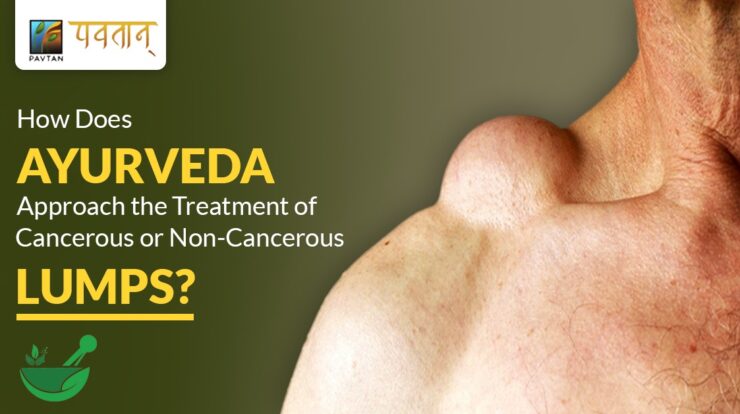
In this generation of new and advanced medicinal systems, Ayurveda stands out as one of the oldest holistic healing systems, originating in ancient India thousands of years ago. With its deep understanding of the body, mind, and spirit, Ayurveda offers unique insights into addressing various health concerns, including the treatment of lumps, both cancerous and non-cancerous.
Lumps, whether benign or malignant, are often a cause for concern, necessitating individuals to seek medical attention. In Ayurveda, the approach to addressing lumps is a little different to the conventional method, focusing on restoring balance to the body and eliminating the root cause of the condition rather than merely addressing the symptoms. Let’s delve deeper into Ayurvedic perspectives on treating cancerous and non-cancerous lumps.
What is a Benign Lump or Tumor?
Benign tumors are non-cancerous growths that do not spread to other parts of the body.
These tumors typically grow slowly and sometimes are contained within a fibrous capsule and do not affect surrounding tissues.
Benign tumors usually do not cause serious health problems unless they grow large enough to exert pressure on nearby structures, leading to symptoms such as pain or discomfort.
Examples of benign tumors include uterine fibroids, lipomas (fatty tumors), and meningiomas (brain tumors).
What is a Malignant Lump or Tumor?
Malignant lumps are cancerous growth cells that lead to uncontrolled cell growth and the ability to invade nearby tissues and spread to distant parts of the body, a process known as metastasis.
Malignant tumors can originate from various types of cells and tissues in the body, giving rise to different types of cancer such as lung cancer, breast cancer, prostate cancer, and leukemia, among others.
The growth of malignant tumors is often rapid and can lead to a range of symptoms depending on their location and size, including pain, weight loss, fatigue, and changes in bodily functions.
What are the Ayurvedic Medicines or Treatment Used to Treat Cancerous or Non-Cancerous Lumps?
So far there is no concrete ayurvedic treatment for Lump cancer. However, you could try these ayurvedic treatments for this problem.
Udwartana: This herbal medicine maintains the lump’s size. A very penetrating herbal lymphatic massage called Udwartana helps to stop further fat accumulation. Udwartana improves blood circulation and digestion eliminates lymphatic toxins from the body, and balances the Kapha dosha.
Vamana: Vamana treatment is given to patients who have a severe Kapha imbalance. One of the five panchakarma cleansing techniques, Vamana, needs to be applied to the patient’s suffering.
Copper: According to Ayurveda, copper can be used to cure cancer or lump overgrowth. After letting the water sit in a copper container overnight, drink it first thing the next morning. Wait two hours if you feel like you might puke up after drinking this water.
Ayurvedic Treatment Approaches
Ayurvedic treatment strategies for addressing lumps typically involve a combination of dietary & lifestyle changes, herbal remedies, detoxification therapies, and mind-body practices. The specific approach may vary depending on factors such as the type and severity of the lump, the individual’s attribute (Prakriti), and their overall health status.
Balancing the Doshas
In Ayurveda, lumps are often viewed as a manifestation of underlying doshic imbalances. Therefore, treatment aims to restore harmony to the doshas through targeted areas. For instance, if the lump is associated with an excess of Kapha dosha, therapies that help alleviate Kapha accumulation, such as dietary modifications to reduce heavy and oily foods, may be recommended. Similarly, if Vata or Pitta imbalances are involved, specific dietary and lifestyle adjustments tailored to pacify these doshas may be prescribed.
Detoxification and Purification
Detoxification plays a crucial role in Ayurvedic treatment protocols for lumps. Panchakarma, a comprehensive detoxification therapy, is often done to eliminate ama (toxins) from the body and restore balance to the doshas. Panchakarma procedures such as Virechana (therapeutic purgation) and Basti (medicated enema) are particularly beneficial in removing accumulated toxins and promoting tissue rejuvenation.
Herbal Remedies
Ayurveda harnesses the therapeutic properties of numerous herbs to support the body’s natural healing processes and address specific health concerns. In the case of lumps, herbal remedies may be prescribed to reduce inflammation, promote cellular regeneration, and support immune function. Commonly used herbs for this purpose include Turmeric (Curcuma longa), Ashwagandha (Withania somnifera), Triphala, Guggulu (Commiphora mukul), and Tulsi (Ocimum sanctum).
Mind-Body Practices
Ayurveda recognizes the true connection between the mind and body and emphasizes the importance of mental and emotional well-being in maintaining overall health. Practices such as meditation, yoga, and pranayama (breathwork) are integral components of Ayurvedic treatment protocols, helping to reduce stress, enhance resilience, and promote a sense of inner balance and harmony.
Individualized Approach
One of the benchmarks of Ayurveda is its personalized approach to healthcare. Ayurvedic practitioners assess each individual’s ideal problem, imbalances, and specific health concerns to plan their treatment accordingly. This individualized approach ensures that interventions are targeted and effective, addressing the root cause of the condition rather than merely addressing its symptoms.
Conclusion
Ayurveda offers a holistic and integrative approach to treating both cancerous and non-cancerous lumps, restoring the balance of the body, mind, and spirit. Ayurvedic treatment aims to promote healing and support overall well-being. However, it’s essential to consult with a qualified Ayurvedic practitioner for personalized guidance and appropriate management of any health condition.
